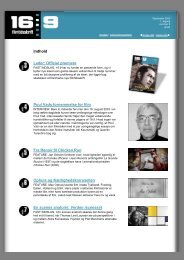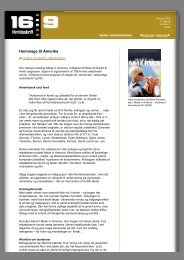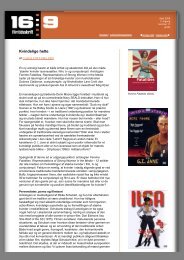You also want an ePaper? Increase the reach of your titles
YUMPU automatically turns print PDFs into web optimized ePapers that Google loves.
Fig. 4: Scottish historian Thomas Carlyle<br />
(1795-1881.<br />
Fig. 5.<br />
Fig. 5-7: The political biopic has a long-running tradition in America and includes wellknown<br />
films like W (2008), Nixon (1996) and The Young Mr. Lincoln (1939).<br />
The Political Biopic<br />
A rather vague and often neglected genre, the biopic may generally be<br />
construed as a ‘genre depicting the life of a famous person in an often<br />
dramatic form’ (Schepelern 2010, p. 81; see also Nielsen 2011). This<br />
genre, thus, includes a variety of different films: from musical biopics<br />
(films like Ray [2004] or Walk the Line [2005]) to philosophical biopics<br />
(films dealing with major thinkers such as Voltaire [1933]) and, as<br />
mentioned, political biopics,dealing with people who have (had) a great<br />
influence on political events and the political system (from fictionalized<br />
accounts of presidential lives to films like Malcolm X [1992] or Milk<br />
[2008], about the gay activist Harvey Milk, played by Sean Penn (fig.<br />
8-9)).<br />
We may naturally assume that this genre (as most of Hollywood’s<br />
classical genres) harks back to the infancy, if not the very birth, of<br />
cinema. Even so, says Rick Altman, early biopics like Warner Bros.’<br />
Disraeli (1929) (fig. 10) were not originally produced and advertised as<br />
biopics (Altman 2002, p. 39). “Films are always available for<br />
redefinition […] and genres for realignment,” writes Altman, and,<br />
thusly, political biopics may have existed for many decades, but the<br />
term itself – political biopic – is relatively new and only vaguely<br />
defined (cf. Altman 2002, p. 42-44).<br />
That political biopics are only vaguely defined is hardly a surprise,<br />
given the fact that the biopic is actually a rather vague genre with only<br />
a few, if any, necessary stylistic features. Trying more specifically to<br />
define the political biopic, however, we could point to a number of<br />
features which are often, but not necessarily, seen in such films,<br />
including<br />
An actor playing a central political figure, whose life is depicted<br />
and dramatized;<br />
An emphasis on tour de force acting, particularly the<br />
physical and psychological characteristics of the portrayed<br />
politician, e.g. in relation to facial and bodily appearance, verbal<br />
dexterity, gesticulations and mimicry (2);<br />
A fictionalized account of authentic historical events;<br />
A dual focus on the political figure as a public and private<br />
character;<br />
A success tragedy structure, often juxtaposing a private<br />
and Gus Van Sant’s Milk (2008), about a<br />
lesser known political activist, could both be<br />
considered political biopics. This subgenre,<br />
in other words, can focus on virtually any<br />
kind of political figure who has (had) an<br />
influence on the political system.<br />
Fig. 10: George Arliss stars as the former<br />
British Prime Minister Benjamin Disraeli in<br />
the 1929 Warner Bros. film Disraeli, which<br />
is known today as an early political biopic.<br />
The film, however, was never produced and<br />
sold using that nomenclature.<br />
2) In the wording of this particular passage<br />
I am indebted to Jakob Isak Nielsen, who<br />
has edited this article.
















